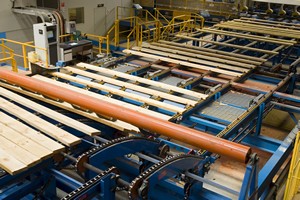Is wood quality still relevant?
 Planting forests is a long term commitment. Choosing the right trees and management regime requires good site knowledge and a long term perspective about the future value of wood. It also requires a better understanding of what constitutes quality from a consumer’s perspective.
Planting forests is a long term commitment. Choosing the right trees and management regime requires good site knowledge and a long term perspective about the future value of wood. It also requires a better understanding of what constitutes quality from a consumer’s perspective.
Only a small premium is paid for higher quality logs in the current market, with maximum returns achieved through increasing log volume. The recent market domination by China has also blurred traditional quality criteria accepted by local wood processors, making this an opportune time to reassess just how important wood quality is for our major markets now and into the future.
Scion recently held two workshops in Rotorua and Christchurch for forest growers, tree breeders, wood processors, researchers and log buyers to discuss issues such as wood quality, market trends and future prospects.
“There was a lot of comment about the China market and how this is influencing wood quality,” says Dr John Moore, Research Leader for Tree Growth and Quality. “China has traditionally had few quality demands, which offers an easy way to deal with wood variability, but it is likely that the uses of radiata pine in China will change as middle class society aspires to follow western trends.
“Some structural markets prefer Chilean radiata pine over New Zealand pine because of the smaller knot size, and we must not lose sight of the recent arrival of European timber in Australasian stores. These developments could threaten radiata pine’s position in the domestic market and highlight the need for us to better understand our markets. We also need to increase our knowledge about wood variation and the drivers behind it, and how to apply this knowledge in the marketing and final use of timber from the forest onwards.”
Segregation of raw material is seen as an immediate challenge for existing forests that are known to be highly variable in wood quality. “Several segregation tools are already available and others are under development,” says forestry scientist, Dr Dave Cown. “Internationally, large integrated companies are well advanced in log segregation techniques either in the forest or the mill yard. In New Zealand, smaller organisations need to ensure that the benefits outweigh the costs, particularly when it comes to the additional skid space required and the costs associated with this. It’s just not practical on many New Zealand sites due to conditions such as slope and harvest volumes from small woodlots.
“While most wood quality features are strongly heritable, they compete in the breeding programme with other traits such as volume and disease resistance. It is also a disincentive for growers that the benefits accrue to others further down the value chain.”
According to Dr John Butcher, CEO of the Radiata Pine Breeding Company, breeding for volume is easy to justify, but improved wood quality is more difficult to validate and growers are not getting clear signals from processors about what the desirable traits are. “What was conclusive from these workshops was that the industry must not lose focus on the quality of our wood products,” he says.
While forest management models can be used to address simple quality issues like wood density and stiffness, more complex characteristics such as those influencing stability and appearance are difficult because of gaps in our knowledge. Scion aims to address some of these issues as part of the ‘Growing Confidence in Forestry’s Future’ research programme. The programme focuses on making improvements throughout the forest growing cycle for both current and future forests that will boost profitability under intensified management regimes, while trying to improve the uniformity and consistency of wood properties.
What was conclusive from both workshops is that there is unrealised opportunity to create more value from our forest resources, and Scion is in the process of exploring this proposition through better communications between all sectors of the forest industry.
For further information: Contact Peter Clinton
